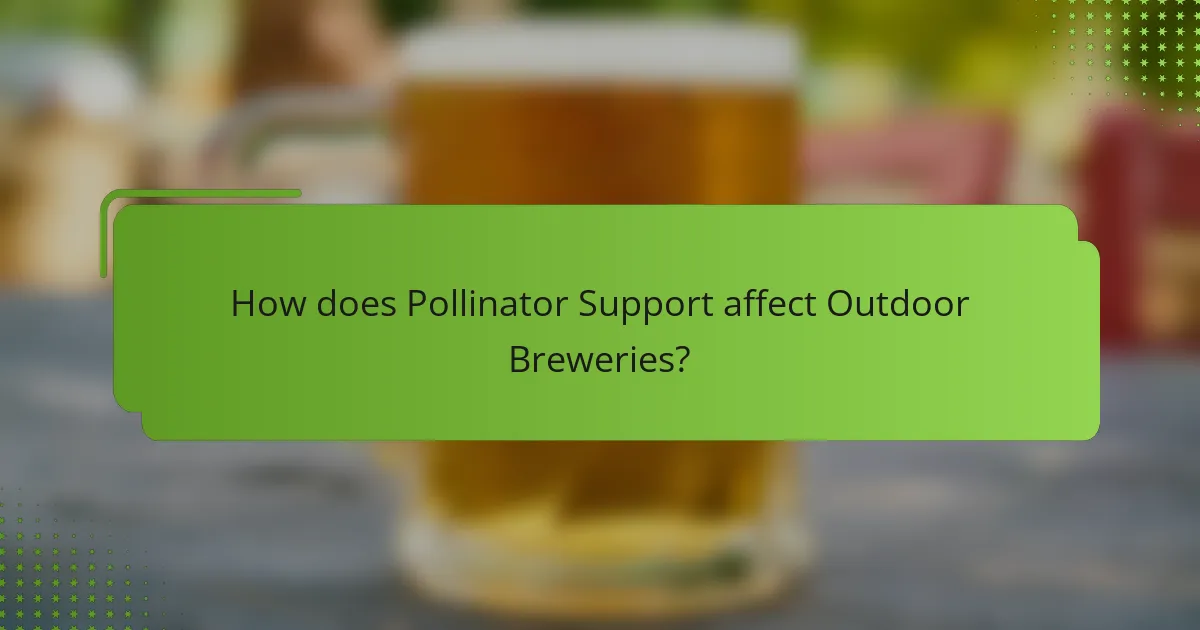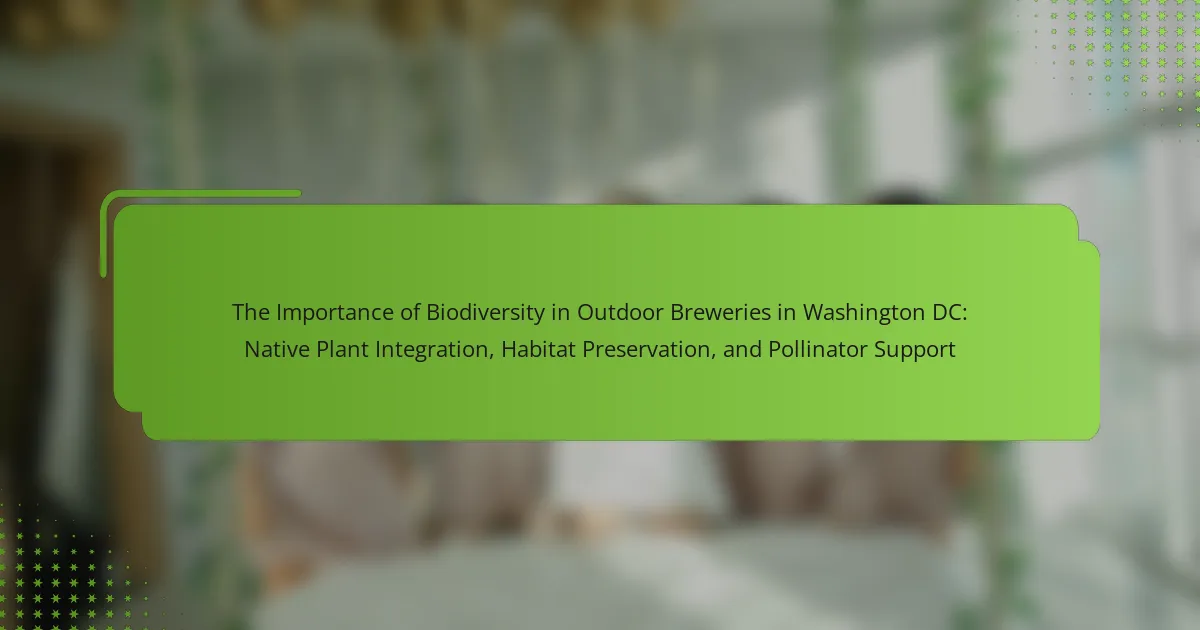Biodiversity is essential for outdoor breweries in Washington DC, as it supports ecological balance and sustainability. The article explores how native plant integration enhances biodiversity, improves soil health, and attracts pollinators, leading to better crop yields for brewing ingredients. Habitat preservation is highlighted as a critical factor in maintaining local ecosystems, which directly impacts water quality and soil health. Additionally, the support of pollinators is shown to increase production rates and ingredient quality, demonstrating the interconnectedness of biodiversity and successful brewing practices. Overall, the article emphasizes the importance of these elements in fostering both brewery success and environmental stewardship.

What is the Importance of Biodiversity in Outdoor Breweries in Washington DC?
Biodiversity is crucial for outdoor breweries in Washington DC as it enhances ecological balance and sustainability. Diverse plant species support a variety of microorganisms, which improve soil health. Healthy soil leads to better crop yields for brewing ingredients. Additionally, biodiversity attracts pollinators essential for the growth of many plants. A thriving ecosystem also helps control pests naturally, reducing the need for chemical interventions. Furthermore, incorporating native plants can create habitats for local wildlife, promoting conservation efforts. This integration of biodiversity ultimately contributes to the quality and uniqueness of the brewery’s products.
Why is biodiversity crucial for outdoor breweries?
Biodiversity is crucial for outdoor breweries because it enhances ecosystem resilience and supports sustainable practices. Diverse ecosystems provide essential services such as pollination, which is vital for the growth of hops and other ingredients. A variety of plants attracts a range of pollinators, ensuring the health of crops. Additionally, biodiversity promotes soil health and nutrient cycling, which are key for quality ingredient production. Studies show that breweries integrating native plants see improved yields and flavors in their products. This integration also helps in habitat preservation, benefiting local wildlife. Therefore, fostering biodiversity directly contributes to the operational success and environmental sustainability of outdoor breweries.
What role does biodiversity play in ecosystem health?
Biodiversity is crucial for ecosystem health. It enhances resilience, allowing ecosystems to recover from disturbances. Diverse species contribute to various ecological functions. These functions include nutrient cycling, pollination, and pest control. Healthy ecosystems with high biodiversity support more stable food webs. They also provide habitats for a wide range of organisms. Studies show that ecosystems with greater biodiversity are more productive. For instance, a study published in “Nature” found that biodiversity loss can reduce ecosystem productivity by up to 50%.
How does biodiversity impact the brewing process?
Biodiversity significantly impacts the brewing process by enhancing the quality and variety of ingredients. Diverse ecosystems provide a range of native plants that contribute unique flavors to brews. These plants, including various grains and hops, can thrive in healthy habitats. Healthy habitats support pollinators, which are essential for the reproduction of many brewing ingredients.
Research shows that breweries utilizing local biodiversity can produce distinct and regionally inspired beers. For instance, the integration of native flora can improve soil health, leading to better crop yields. A study by the American Society of Brewing Chemists highlights that diverse microbial communities in brewing can influence fermentation dynamics. This results in more complex flavor profiles and improved overall quality of the beer.
Thus, biodiversity is crucial for sustainable brewing practices and the development of unique, high-quality products.
What are the key components of biodiversity in outdoor breweries?
Key components of biodiversity in outdoor breweries include native plants, wildlife habitats, and pollinator support. Native plants provide essential resources for local ecosystems. They attract various pollinators, which are crucial for plant reproduction. Wildlife habitats support diverse species and promote ecological balance. These elements enhance the sustainability of outdoor breweries. Studies show that integrating biodiversity improves beer quality and flavor. Additionally, diverse ecosystems can increase resilience against pests and diseases. Thus, outdoor breweries benefit significantly from maintaining biodiversity.
What types of native plants are integrated into outdoor breweries?
Outdoor breweries often integrate native plants such as milkweed, coneflower, and black-eyed Susan. These plants provide essential habitats for local pollinators. Milkweed attracts monarch butterflies, which are vital for ecosystem health. Coneflowers and black-eyed Susans offer nectar sources for various bees and insects. Incorporating these native species supports biodiversity and enhances the brewery’s environmental sustainability. Studies show that native plants contribute to improved local ecosystems by providing food and shelter for wildlife.
How do these plants contribute to the brewery’s ecosystem?
These plants enhance the brewery’s ecosystem by providing essential habitats for local wildlife. They attract pollinators such as bees and butterflies, which are crucial for plant reproduction. Native plants improve soil health through their root systems, preventing erosion and promoting nutrient cycling. They also contribute to biodiversity, creating a balanced ecosystem that supports various species. Additionally, these plants can help filter rainwater, reducing runoff and improving water quality. Studies show that incorporating native vegetation increases overall ecosystem resilience. This integration supports sustainable brewing practices and fosters a healthier environment.

How does Native Plant Integration benefit Outdoor Breweries?
Native plant integration benefits outdoor breweries by enhancing biodiversity and improving ecosystem health. This integration leads to better soil quality, which supports healthier plants. Healthier plants contribute to improved aesthetics and customer experience at breweries. Native plants attract beneficial insects, including pollinators, which are essential for plant reproduction. Increased pollinator activity can enhance the quality of ingredients used in brewing. Research shows that diverse ecosystems are more resilient to pests and diseases. This resilience can reduce the need for chemical interventions, promoting organic practices. Overall, native plant integration creates a sustainable environment that supports both breweries and local ecosystems.
What are the advantages of using native plants in outdoor breweries?
Using native plants in outdoor breweries offers several advantages. Native plants require less water and maintenance compared to non-native species. They are adapted to the local climate and soil conditions, promoting sustainability. These plants support local wildlife, including pollinators essential for ecosystem health. Research shows that native plants can increase biodiversity, enhancing the brewery’s natural environment. Additionally, they can improve soil health and reduce erosion. Incorporating native plants can also create a unique aesthetic that reflects local heritage. Overall, using native plants contributes to ecological balance and operational efficiency in outdoor breweries.
How do native plants enhance flavor profiles in beer?
Native plants enhance flavor profiles in beer by contributing unique aromatic compounds. These compounds, such as terpenes and phenolics, add complexity to the beer’s taste. For example, plants like juniper and elderflower impart distinct herbal and floral notes. Studies show that using local flora can create flavors that resonate with the regional terroir. Additionally, native plants often have lower cultivation inputs, leading to sustainable brewing practices. This integration supports biodiversity while enriching the sensory experience of the beer. The use of native ingredients aligns with trends in craft brewing focused on local sourcing and environmental responsibility.
What ecological benefits do native plants provide?
Native plants provide essential ecological benefits that support local ecosystems. They enhance biodiversity by offering habitats for various wildlife species. Native plants are adapted to local climates and soils, requiring less water and maintenance. They support pollinators, such as bees and butterflies, which are crucial for plant reproduction. Research shows that landscapes with native plants have higher insect diversity. They also improve soil health by preventing erosion and promoting nutrient cycling. Native plants can help filter pollutants, improving water quality in nearby streams and rivers. Their presence contributes to the overall resilience of ecosystems against climate change.
How can breweries effectively integrate native plants?
Breweries can effectively integrate native plants by incorporating them into their landscaping and brewing processes. This approach enhances biodiversity and supports local ecosystems. Planting native species requires selecting plants that thrive in the local climate and soil conditions. Native plants often require less water and maintenance compared to non-native species.
Breweries can also use native plants in their brewing recipes. For example, local herbs and flowers can add unique flavors to beers. Collaborating with local horticulturists can help breweries choose the best plants for their needs. Additionally, creating habitats for pollinators can increase plant productivity and improve crop yields.
Research shows that integrating native plants can increase local biodiversity by providing habitat and food sources for wildlife. A study by the University of Maryland found that native plant gardens support more insect species than non-native gardens. This integration not only benefits the environment but can also enhance the brewery’s brand image and appeal to eco-conscious consumers.
What strategies can breweries use for plant selection?
Breweries can use several strategies for plant selection to enhance biodiversity. First, they should prioritize native plant species. Native plants are adapted to local conditions and support local ecosystems. Second, breweries can implement companion planting. This method involves planting different species together to improve growth and pest resistance. Third, they can focus on selecting plants that attract pollinators. Pollinator-friendly plants can increase crop yields and promote biodiversity.
Additionally, breweries should consider the growth conditions of the plants. Selecting plants that thrive in the specific soil and climate of Washington DC can lead to better sustainability. They can also engage with local agricultural experts for tailored advice. This collaborative approach ensures that plant selection aligns with ecological goals. By integrating these strategies, breweries can effectively contribute to habitat preservation and support local wildlife.
How can breweries design their landscapes for biodiversity?
Breweries can design their landscapes for biodiversity by incorporating native plants. Native plants support local wildlife and promote ecosystem health. They require less water and maintenance compared to non-native species. Breweries should create diverse habitats, including meadows, gardens, and wetlands. These habitats attract pollinators like bees and butterflies. Additionally, breweries can implement rain gardens to manage stormwater. This practice enhances water quality and provides habitat for aquatic species. Studies show that diverse plantings increase insect populations, which benefits the overall ecosystem. By prioritizing biodiversity, breweries contribute to environmental sustainability.

What is the role of Habitat Preservation in Outdoor Breweries?
Habitat preservation plays a critical role in outdoor breweries by maintaining the ecological balance necessary for sustainable brewing practices. It ensures the protection of local flora and fauna, which contribute to the biodiversity essential for healthy ecosystems. Outdoor breweries often rely on natural resources, including water quality and soil health, which are directly impacted by habitat preservation efforts. For example, preserving riparian zones around water sources helps filter pollutants and supports aquatic life, enhancing the overall brewing environment. Additionally, healthy habitats support pollinators, which are vital for the growth of many brewing ingredients, such as hops. Studies show that breweries that engage in habitat preservation can improve product quality while fostering community engagement and environmental stewardship. This approach not only benefits the brewery but also contributes positively to the local ecosystem and economy.
Why is habitat preservation important for breweries?
Habitat preservation is crucial for breweries because it supports biodiversity essential for brewing ingredients. Healthy ecosystems provide vital resources like clean water and resilient crops. Preserved habitats also promote pollinator populations, which are necessary for the growth of many ingredients used in brewing. For instance, studies show that increased pollinator activity can enhance the yield of hops, a key ingredient in beer production. Additionally, maintaining local flora contributes to the unique flavors of craft beers, reflecting the region’s biodiversity. Breweries that engage in habitat preservation can also enhance their brand reputation and attract environmentally conscious consumers.
How does habitat preservation support local wildlife?
Habitat preservation supports local wildlife by providing essential resources for survival. It offers food, shelter, and breeding grounds for various species. This stability fosters biodiversity, which is crucial for ecosystem health. For example, preserved habitats maintain populations of pollinators, which are vital for plant reproduction. Studies show that areas with intact habitats have higher species richness. This richness contributes to resilience against environmental changes. Additionally, habitat preservation mitigates the effects of habitat fragmentation. It allows wildlife to thrive and maintain genetic diversity. Overall, preserving habitats is fundamental for sustaining local wildlife populations.
What are the consequences of habitat loss for breweries?
Habitat loss negatively impacts breweries by reducing biodiversity essential for brewing ingredients. The decline in native plant species affects the availability of key crops like barley and hops. This can lead to increased costs for breweries as they may need to source ingredients from farther locations. Reduced biodiversity also impacts local ecosystems, which can affect water quality and soil health. These factors can ultimately compromise the quality of the beer produced. Additionally, habitat loss can diminish pollinator populations, essential for many crops. A study by the National Academy of Sciences highlights that 75% of global food crops rely on animal pollination. Therefore, habitat loss poses significant risks to breweries’ sustainability and product quality.
What practices can breweries adopt for habitat preservation?
Breweries can adopt several practices for habitat preservation. Implementing native plant landscaping enhances local biodiversity. This attracts pollinators and supports ecosystem health. Utilizing rainwater harvesting reduces water runoff and conserves resources. Installing permeable surfaces minimizes soil erosion and promotes groundwater recharge. Creating buffer zones around water bodies protects aquatic habitats. Engaging in community outreach raises awareness about local ecosystems. Collaborating with conservation organizations can lead to effective habitat restoration projects. These practices contribute to a sustainable brewing operation and a healthier environment.
How can breweries create wildlife-friendly environments?
Breweries can create wildlife-friendly environments by integrating native plants into their landscaping. Native plants support local ecosystems and provide habitat for wildlife. They require less maintenance and water than non-native species. Breweries can also establish pollinator gardens to attract bees and butterflies. These gardens enhance biodiversity and improve pollination for surrounding crops. Additionally, breweries can preserve existing habitats on their property. This includes protecting trees, wetlands, and grasslands that serve as wildlife corridors. Implementing sustainable practices, such as reducing chemical use, also benefits local wildlife. These actions contribute to a healthier ecosystem and promote biodiversity.
What partnerships can breweries establish for habitat conservation?
Breweries can establish partnerships with environmental organizations for habitat conservation. These partnerships often focus on initiatives like reforestation and wetland restoration. Collaborating with local conservation groups can enhance biodiversity around brewery locations. Additionally, breweries can partner with universities for research on native plant integration. Engaging with government agencies can secure funding for habitat projects. Collaborations with community organizations can promote awareness about habitat preservation. These partnerships can also lead to joint events that educate the public on conservation efforts. Effective partnerships can result in measurable environmental benefits and community engagement.

How does Pollinator Support affect Outdoor Breweries?
Pollinator support positively affects outdoor breweries by enhancing crop yields and improving biodiversity. Healthy pollinator populations increase the efficiency of pollination for plants used in brewing, such as hops and various fruits. This results in higher quality ingredients and increased production rates. Additionally, supporting pollinators fosters a balanced ecosystem, which can lead to better pest control and reduced need for chemical interventions. Studies show that breweries integrating native plants and pollinator habitats experience improved overall productivity. For example, breweries that engage in pollinator-friendly practices report up to a 30% increase in hop yields. This demonstrates a clear link between pollinator support and successful outdoor brewing operations.
Why are pollinators vital for outdoor breweries?
Pollinators are vital for outdoor breweries because they enhance the growth of essential crops. These crops include hops, which are a key ingredient in beer production. Pollinators, such as bees, facilitate the pollination process, leading to increased yield and quality of hops. Research shows that approximately 75% of the world’s flowering plants rely on animal pollinators. In outdoor breweries, a healthy population of pollinators contributes to biodiversity, which supports ecosystem stability. This stability can lead to a more resilient agricultural system, benefiting the brewery’s supply chain. Furthermore, breweries that support pollinator habitats can improve their environmental sustainability and attract eco-conscious consumers.
What role do pollinators play in crop production for breweries?
Pollinators are essential for crop production in breweries. They facilitate the reproduction of flowering plants, which are crucial for growing ingredients like barley and hops. Approximately 75% of the world’s food crops depend on pollinators, including those used in brewing. Effective pollination increases crop yields and enhances the quality of the harvest. Studies show that crops with higher pollinator activity produce more grains and better flavor profiles. This relationship supports the brewery’s sustainability and economic viability. Therefore, protecting pollinator habitats is vital for the success of breweries reliant on these crops.
How does pollinator health impact biodiversity?
Pollinator health directly influences biodiversity by ensuring the reproduction of many flowering plants. These plants provide essential habitats and food sources for various wildlife species. Healthy pollinators contribute to the genetic diversity of plant populations. This diversity enhances ecosystem resilience against diseases and climate change. Studies show that about 75% of global food crops depend on animal pollination. A decline in pollinator health can lead to reduced plant diversity. This, in turn, affects the entire food web, including herbivores and predators. Therefore, maintaining pollinator health is crucial for sustaining biodiversity in ecosystems.
What initiatives can breweries implement to support pollinators?
Breweries can implement initiatives such as planting native flowering plants to support pollinators. Native plants provide essential food sources for bees and butterflies. Establishing pollinator gardens can enhance local biodiversity. Breweries can also create habitats by installing bee hotels. These structures offer nesting sites for solitary bees. Additionally, breweries can avoid using pesticides harmful to pollinators. Educating staff and customers about pollinator conservation is another effective initiative. Collaborating with local conservation organizations can further strengthen these efforts. These initiatives positively impact the local ecosystem and brewery reputation.
How can breweries create pollinator-friendly habitats?
Breweries can create pollinator-friendly habitats by integrating native plants into their landscapes. Native plants provide essential food sources for pollinators like bees and butterflies. Breweries should prioritize planting a variety of flowering species that bloom throughout the growing season. This ensures a continuous supply of nectar and pollen.
Additionally, breweries can maintain habitats by avoiding pesticide use. Pesticides can harm pollinators and disrupt their populations. Breweries can also create nesting sites by leaving areas of bare ground or incorporating bee hotels. These features support solitary bees, which are vital pollinators.
Moreover, breweries can engage in community education about pollinator conservation. Hosting workshops or informational sessions can raise awareness and encourage local participation. By implementing these strategies, breweries contribute to the health of local ecosystems and support biodiversity.
What community engagement strategies can breweries use to promote pollinator awareness?
Breweries can use educational workshops to promote pollinator awareness. These workshops can teach community members about the importance of pollinators. Engaging local schools in field trips to breweries can also raise awareness. Breweries can host community events focused on pollinator-friendly practices. Collaborating with local environmental organizations can amplify outreach efforts. Offering incentives for patrons to plant pollinator gardens encourages participation. Breweries can create informational signage about pollinators on-site. Partnering with local farmers can showcase the connection between agriculture and pollinators.
What are the best practices for enhancing biodiversity in outdoor breweries?
Implementing native plant integration is a best practice for enhancing biodiversity in outdoor breweries. Native plants provide food and habitat for local wildlife. They require less water and maintenance compared to non-native species. Creating diverse plantings supports various pollinators, which are crucial for ecosystem health.
Establishing habitats such as wildflower meadows or native shrub areas can attract beneficial insects. Maintaining a variety of habitats increases overall biodiversity. Installing birdhouses and bat boxes can also support local fauna.
Limiting pesticide use is essential for protecting beneficial species. Organic farming practices promote healthier ecosystems. Collaborating with local conservation groups can provide additional resources and expertise.
These practices contribute to a thriving environment that benefits both the brewery and the surrounding ecosystem.
What steps can breweries take to monitor and evaluate biodiversity efforts?
Breweries can monitor and evaluate biodiversity efforts by implementing specific strategies. First, they should establish baseline biodiversity assessments to understand current conditions. This can include cataloging native plant species and documenting local wildlife. Second, breweries can create biodiversity action plans that set clear goals and measurable objectives. Third, regular monitoring should be conducted using standardized methods, such as transect surveys or species inventories. Fourth, breweries can engage with local conservation organizations for expert guidance and support. Additionally, they should track changes in biodiversity over time through repeated assessments. Finally, breweries can report their findings publicly to promote transparency and encourage community involvement. These steps ensure breweries effectively contribute to biodiversity conservation.
How can breweries educate visitors about biodiversity initiatives?
Breweries can educate visitors about biodiversity initiatives through guided tours and informational signage. These tours can highlight native plant species used in brewing. Signage can explain the importance of habitat preservation. Workshops can be organized to engage visitors in hands-on activities. Educational materials can be distributed, detailing local biodiversity efforts. Collaborations with environmental organizations can enhance educational outreach. Interactive displays can illustrate the role of pollinators in brewing ingredients. Events like biodiversity days can foster community involvement and awareness.
The main entity of the article is biodiversity in outdoor breweries in Washington DC. The article emphasizes the significance of biodiversity for enhancing ecological balance, sustainability, and the quality of brewing ingredients. It covers the integration of native plants, habitat preservation, and pollinator support as critical components that contribute to healthier ecosystems and improved crop yields. Furthermore, the article discusses the benefits of these practices for both the breweries and local wildlife, highlighting the importance of biodiversity for sustainable brewing operations and community engagement.
